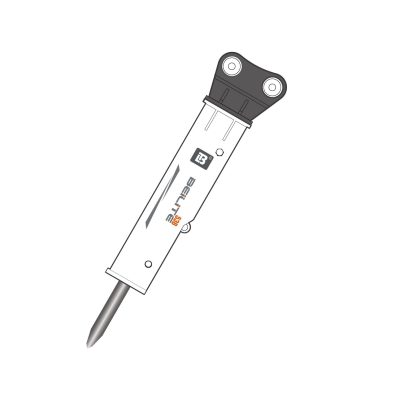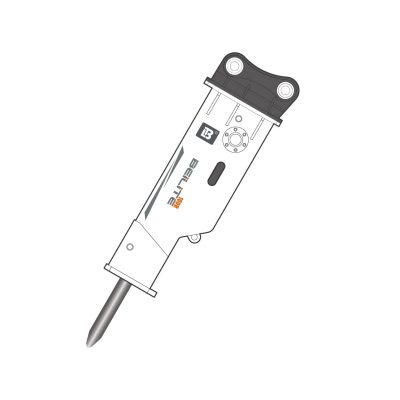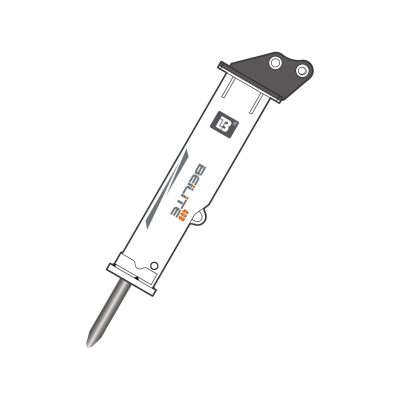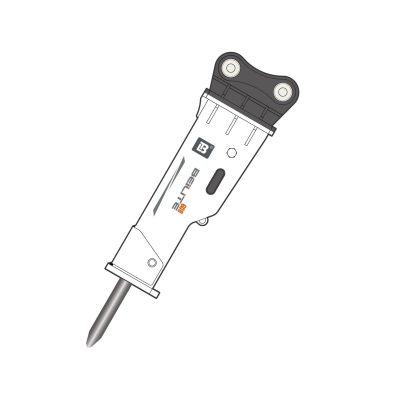¿Cómo elijo un martillo hidráulico?
Elegir bien martillo hidráulico garantiza un trabajo eficiente y la seguridad del equipo. Los operadores y contratistas deben evaluar los factores clave antes de seleccionar un martillo hidráulico que se adapte a sus proyectos y maquinaria.
¿Qué es un martillo hidráulico?
A martillo hidráulico utiliza presión hidráulica para romper rocas, hormigón y asfalto. Esta herramienta se acopla a máquinas portadoras como excavadoras y minicargadoras. Seleccionar un martillo hidráulico que se adapte a la máquina portadora y al trabajo aumenta la eficiencia del trabajo y protege el equipo.
Factores clave a tener en cuenta al elegir un martillo hidráulico
Compatibilidad con transportistas
Los operadores deben garantizar que compatibilidad del martillo hidráulico con el portador. Cada martillo hidráulico requiere un caudal de aceite y unos niveles de presión específicos. Los portadores deben cumplir estos requisitos hidráulicos para que el martillo funcione eficientemente. Un desajuste puede dañar tanto el portador como el martillo hidráulico.
Selección del tamaño del disyuntor
Los usuarios deben seleccione el tamaño del martillo hidráulico en función del peso y la capacidad hidráulica del portador. Los martillos más grandes manipulan materiales más duros pero requieren portadoras más fuertes. Los martillos más pequeños se adaptan a máquinas compactas y tareas más ligeras. Un dimensionamiento adecuado evita la sobrecarga del equipo y mantiene un funcionamiento seguro.
Condiciones de trabajo y requisitos de solicitud
Los jefes de proyecto deben evaluar martillo hidráulico aplicación entorno. Para trabajos en interiores o tareas con espacio restringido, los martillos hidráulicos más pequeños ofrecen una mejor maniobrabilidad. Las tareas pesadas en exteriores requieren martillos hidráulicos más grandes para una potencia de rotura eficiente.
Especificaciones del martillo hidráulico
Los compradores deben comprobar especificaciones del martillo hidráulico como la presión de trabajo, el rango de caudal de aceite y el diámetro de la herramienta. Unas especificaciones correctas garantizan un funcionamiento sin problemas. Una adaptación adecuada evita averías en el equipo y minimiza el tiempo de inactividad.
Energía de impacto y golpes por minuto
En rendimiento del martillo hidráulico depende de su energía de impacto y de los golpes por minuto. Una mayor energía de impacto proporciona golpes más fuertes para materiales duros. Los golpes por minuto indican la velocidad de golpeo. Elegir el equilibrio adecuado maximiza la productividad y se adapta a la tarea específica.
Tipos de martillos hidráulicos y sus aplicaciones
Los operadores pueden elegir entre dos martillo hidráulico tipos: ligeros y pesados. Los martillos ligeros se adaptan a portadores más pequeños y funcionan bien en espacios reducidos. Los martillos pesados pueden con grandes rocas y estructuras de hormigón. La selección del tipo correcto garantiza la eficacia del proyecto y la seguridad del equipo.
Cómo influye el tamaño de la máquina en la selección del martillo hidráulico
El tamaño del soporte influye directamente en compatibilidad del martillo hidráulico. Los soportes deben proporcionar el caudal de aceite y la presión hidráulica adecuados. El uso de un portador de tamaño insuficiente o excesivo provoca un funcionamiento ineficaz y puede dañar el equipo. Adaptar el tamaño del portador al tamaño del martillo garantiza un rendimiento fiable.
Evaluación del entorno de trabajo y la dureza del material
Los operadores deben evaluar la dureza del material y las restricciones medioambientales antes de elegir un martillo hidráulico. Los materiales más blandos, como el asfalto, requieren menos energía de impacto. Las rocas duras requieren martillos de mayor energía. Comprender estos factores ayuda a los operadores a seleccionar el martillo adecuado para lograr resultados óptimos.
Comprender el rendimiento de los martillos hidráulicos
Los equipos de trabajo deben medir rendimiento del martillo hidráulico en función de la energía de impacto, los golpes por minuto y la presión de funcionamiento. Los martillos eficientes mantienen un rendimiento estable sin sobrecargar el portador. Los equipos deben comprobar estos parámetros para garantizar un funcionamiento seguro y eficaz en todos los proyectos.
Importancia del mantenimiento adecuado de los martillos hidráulicos
Los operadores deben seguir estrictamente mantenimiento de martillos hidráulicos programas. La inspección periódica de los casquillos, el desgaste de los cinceles y los conductos hidráulicos prolonga la vida útil del equipo. Una lubricación adecuada y la sustitución oportuna de las piezas evitan daños y garantizan un rendimiento constante del martillo.
Cómo adaptar las herramientas hidráulicas a tareas específicas
Las diferentes herramientas de martillo hidráulico se adaptan a tareas específicas. Las puntas rompedoras rompen rocas duras. Los cinceles cortan el hormigón armado. Las herramientas romas procesan grandes masas de hormigón. Los operarios deben seleccionar la herramienta adecuada para cada trabajo y maximizar la eficiencia.
Errores comunes al elegir un martillo hidráulico
Muchos usuarios ignoran especificaciones del martillo hidráulico y la compatibilidad del soporte. Otros seleccionan los martillos basándose únicamente en el tamaño, sin tener en cuenta el caudal y la presión del aceite. Evitar estos errores protege tanto al martillo hidráulico como a la máquina portadora de posibles daños.
Por qué los martillos hidráulicos Beilite son una elección fiable
Beilite ofrece una gama completa de martillos hidráulicos para adaptarse a diferentes soportes y aplicaciones. Cada martillo Beilite se somete a estrictos controles de calidad. Beilite ofrece asistencia técnica para ayudar a los clientes a seleccionar el martillo hidráulico adecuado para sus necesidades.
Resumen de consideraciones clave
Los operadores deben evaluar compatibilidad del martillo hidráulicoEl tamaño del portador, la dureza del material y las condiciones de trabajo. La selección del martillo adecuado garantiza la eficiencia del proyecto y reduce el riesgo de avería del equipo. Un mantenimiento adecuado garantiza el rendimiento a largo plazo del martillo hidráulico.
Póngase en contacto con Beilite para obtener asesoramiento profesional sobre selección
Los expertos de Beilite ayudan a los usuarios a elegir el mejor martillo hidráulico para sus proyectos. Póngase en contacto con Beilite ahora para obtener recomendaciones personalizadas de productos y asistencia detallada.
Preguntas frecuentes
¿Qué tamaño de martillo hidráulico debo elegir?
Usted debe seleccione el tamaño del martillo hidráulico en función del peso de la máquina y de la capacidad del sistema hidráulico. Los martillos más grandes se adaptan a las máquinas más pesadas y a las tareas más exigentes, mientras que los martillos más pequeños se adaptan a las máquinas más compactas y a los trabajos más ligeros.
¿Cómo sé si mi portador es compatible con el martillo hidráulico?
Debe comprobar el compatibilidad del martillo hidráulico comparando el caudal de aceite y la presión hidráulica necesarios con las especificaciones del portador. El portador debe satisfacer plenamente las necesidades hidráulicas del martillo para garantizar un funcionamiento seguro y eficiente.
¿Cómo influye la dureza del material en la selección del martillo hidráulico?
La dureza del material influye directamente rendimiento del martillo hidráulico requisitos. Los materiales más blandos necesitan martillos con menor energía de impacto. Los materiales más duros requieren martillos con mayor energía de impacto y un soporte más fuerte para lograr resultados eficaces.
¿Qué mantenimiento requiere un martillo hidráulico?
Mantenimiento de martillos hidráulicos implica la inspección diaria, la lubricación periódica, la comprobación de los casquillos y la evaluación de la línea hidráulica. Los operarios deben sustituir rápidamente las piezas desgastadas y garantizar una lubricación adecuada de la herramienta para prolongar la vida útil del martillo hidráulico.









